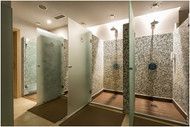What Type Of Shower Valve Is Best For Commercial Buildings?
May 28th 2024
Residential and commercial buildings have different needs when it comes to water use and temperature regulation. While home water consumption is usually under the watchful eye of owners and tenants, in commercial buildings it is a lot more difficult to keep resources under control.
When installing valves, one must take into account several factors before deciding which system will work best.
First of all, one must ask: Is this a residential or a public/commercial building? Then other factors need to be considered. For example, which way is the water flowing through the system? Is it flowing through the valve and back like, for example, at home - where you use only cold and hot water? Or does it flow from source to destination, like for example at public buildings? These are just examples of how things work, there are other variations.
Finally, it is important to consider what needs to happen to the water/steam flow when the valve opens or closes - whether it needs to be completely cut off, or just changed in pressure or temperature.
Two main types of valves can be used to control the flow of water/steam in a system. They are identified by their function. The first type is the pressure balance valve, which is used when the hot and cold water should mix directly. The second type is commercial thermostatic mixing valves, which are the preferred kind when the water only flows from cold to hot. Of course, there are also “mixets” and diverters, and they are usually found in old buildings, but today we are going to focus on the two main types of valves most commercial buildings are opting for when keeping a stable water temperature is important.
Pressure valves are the most common type of shower valve found in most buildings. Schools, hospitals, government facilities, and many large commercial buildings install pressure balance valves given their simplicity.
Their main function is to keep a preset mix between the hot and cold streams, resulting in a balanced temperature. The device is composed of a spool or diaphragm which can move up and down to regulate the flow of water from hot and cold sources. When the pressure from either source drops or spikes, the valve reacts and temporarily adjusts the outflow of water from the opposite source. This ensures you get consistent temperatures, even if other appliances or fixtures, such as toilets, reduce the availability of cold water.
More often than not, commercial pressure valves are made out of brass. This helps with the dimensional stability of the unit, as well as resistance to pitting, corrosion, and cavitation damage. When commercial pressure valves fail, it's usually due to cavitation damage or corrosion to the spool.
Cavitation is the formation of vapor-filled bubbles in a liquid—such as water—typically caused by local pressure drops in a fluid flow. When exposed to low pressures, some liquids will boil spontaneously, forming vapor bubbles at their free surfaces or in pore spaces. These bubbles will collapse as the pressure increases. In areas of high cavitation, the process can slowly erode material from solid surfaces by exposing this material to a localized low-pressure zone.
Commercial thermostatic mixing valves do measure water temperature, providing more granular control of the mix, and can keep temperatures stable even with low pressures. They have been specifically designed with safety and temperature stability in mind, protecting users from scalding shower temperatures.
The way commercial thermostatic mixing works is radically different from PB valves. They have a wax element inside the valve, which is designed to expand and contract depending on changes in water temperature. When the wax moves, it will change the position of a plunger inside the valve, regulating the amount of cold and hot water that goes into your shower head or spigot.
Unlike pressure balance valves, thermostatic shower valves do not mix hot and cold water to a preset temperature. Instead, they sense the actual water temperature and resist fluctuations above a safe threshold. This allows them to deliver accurate temperatures without wasting energy or increasing capital costs. This makes them a favorite in commercial and institutional environments. Gyms, spas, hair salons, and venues where water temperature must ideally remain stable while keeping costs and waste under control. This is why they are often the preferred choice in commercial settings where temperature fluctuation is not acceptable or can cause harm to occupants.
If you have additional questions about how commercial thermostatic valves work, or just want to know the advantages of our different systems, don’t hesitate to contact us. Let us know how we can help and we’d be more than happy to extend our experience to your benefit!

